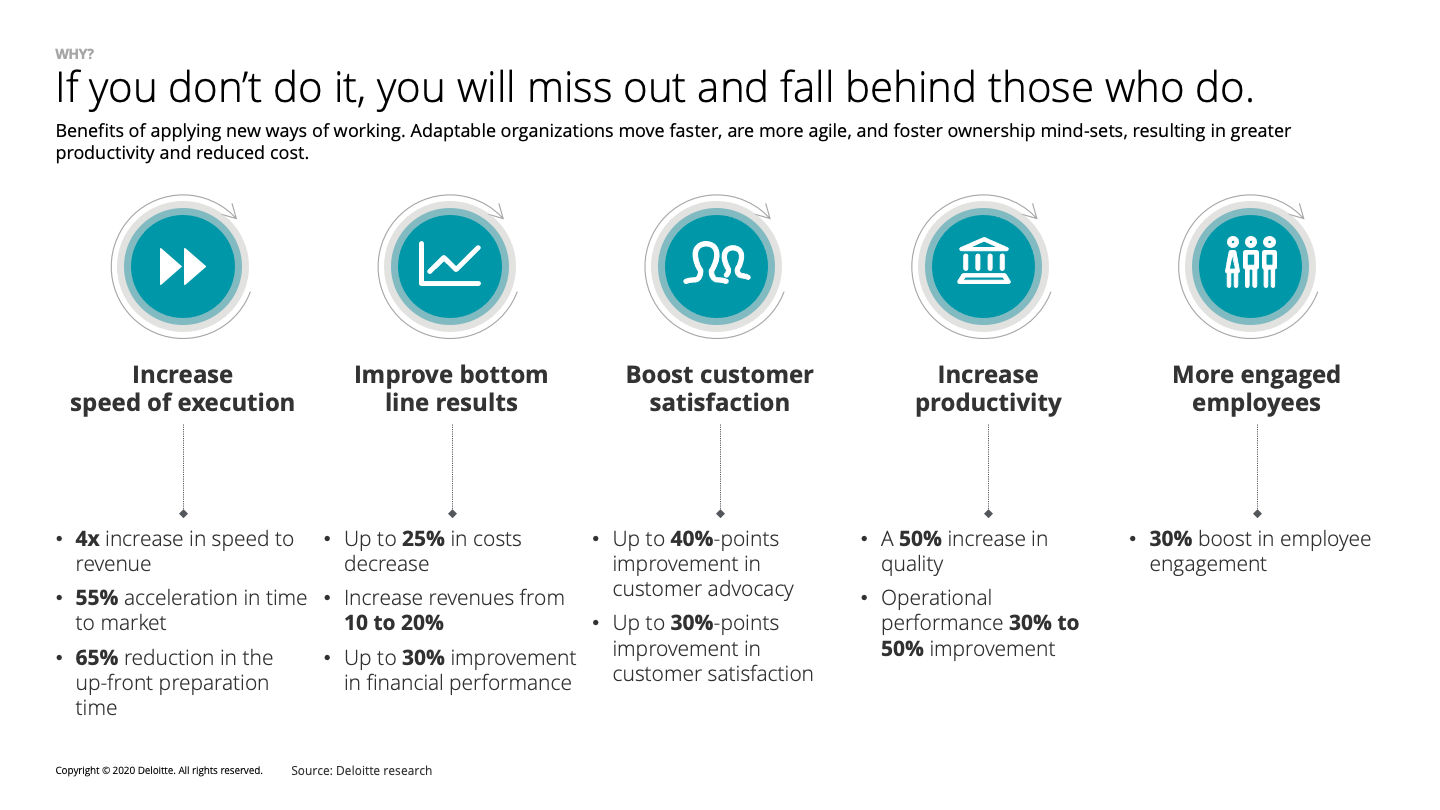Human-Centric Ways of Working: What They Are and Why You Should Care
Dramatic changes are currently happening in our working culture. Work from home. Hybrid work. The great resignation. Agile transformations. Purpose...
3 min read
Dr. Marc Sniukas
Feb 7, 2023 12:00:00 AM
Our fast-moving and digital world is building a tsunami of change, continually evolving our “normal”. As a result, adaptability is the new competitive advantage. To become an agile organization, you must reinvent your ways of working and build capabilities suited to this new reality.
Three key arguments underline why we need to transform how we work.
A volatile and complex environment demands rapid reactions to unpredictable and uncontrollable changes. Businesses around the globe have felt this uncertainty keenly as they navigate the COVID-19 pandemic.
This situation has highlighted a need for adaptability and new ways of working, demonstrating that our linear analyze-plan-implement approach is unsuited to volatile, uncertain, complex, and ambiguous environments.
The industrial-age model, still dominating how we work today, was invented to create scale and efficiency in a stable environment. However, today’s climate is wildly different. While efficiency is still pivotal, we also need a system that is flexible and can handle complexity.
While industrial management was devised for scale, stability, and standardization, new ways of working allow for agility, innovation, speed, responsiveness, creativity, and resilience.
Adaptable organizations move faster, are more agile and foster ownership mindsets, improving productivity and reducing costs. Our research shows organizations that successfully adopt new ways of working can achieve tremendous benefits, boosting their speed in execution, customer satisfaction, employee engagement, productivity and bottom-line results (see figure 1).

To become adaptable, you must transform the way your teams work, your managers lead, and how you operate.
Adaptable organizations share crucial traits in their organizational structures; values and principles of how they work and behave; and core capabilities that allow agility.
Agile organizations have a network of multidisciplinary teams based on capabilities rather than traditional hierarchies and silos. Instead of looking inward, agile organizations exist within purpose-driven ecosystems with defined customer-focused goals.
High-performing teams are a core element of delivering adaptable outcomes. They are enabled by cross-functional and connected members that apply new ways of working. Resilient individuals are nurtured through talent programs that enable learning, professional development and growth.
Adaptive leaders are inclusive orchestrators, not technical taskmasters, who unlock the potential of their teams’ diverse skill-sets through these new leadership capabilities: energize, connect and enable.
While the above building blocks shape the adaptable organization, these five principles are the foundations of new ways of working.
Be purpose-driven: Agile teams have a clear focus, are aligned, and work towards well-defined, shared and customer-focused goals. The creation of user outcomes acts as a common purpose.
Focus on progress and outcomes: Instead of processes and procedures, agile organizations and leaders focus on progress and outcomes. Teams constantly measure and evaluate progress and results to constantly improve, even in uncertain environments.
Collaborate: Collaboration in agile organizations happens from within, through cross-functional teams working together towards shared goals, as well as outside the organization, through ecosystems of stakeholders working towards a shared customer-centric outcome.
Work in the open: Collaboration is enhanced by the transparency of the information required by teams. Communication is frequent, decision-making is transparent, and access to information is open by default rather than on a need-to-know basis.
Be people positive: Being people positive means giving your team autonomy, end-to-end responsibility and execution power. It is showing trust in your team and providing an environment of psychological safety.
These principles can be brought to life through teamwork and collaboration, agile practices, and human-centred innovation and problem-solving. But you cannot create new ways of working using traditional approaches; it requires new ways of transformation based on the following principles.
Outcomes over procedures: Instead of relying on traditional change management approaches that are often communication heavy, agile transformations focus on business outcomes and creating value. This delivers better quality faster, reduces risk, and improves safety. Teams require coaching and support to achieve these outcomes while applying new ways of working, letting them decide which processes are the most appropriate instead of imposing them.
Start small over a big bang: Improving outcomes requires an incremental approach, allowing for gradual learning and adaptation of ways of working. Starting small means starting with fewer teams, learning what works, adjusting what does not and then scaling when you find the best solution. It delivers faster results and fosters the ability to start finishing projects, compared to big change initiatives that often produce results much later.
Invite over enforce: Like any innovation, “organizational innovation” follows the innovation-adoption curve. Instead of concentrating on sceptical or conservative people, focus on enthusiasts and invite people interested in what you are offering. And, once these people produce outcomes, you can create more momentum by including more teams.
Top-down over bottom-up: While it may seem counterintuitive, successful transformations start from the top, meaning the leadership team is first to apply new ways of working. This allows leaders to build their understanding, create a blueprint that identifies how agility adds value, and provide a vision of how the new approach will work.
Through this top-down approach, the executive team can fully grasp why this way of working is required and buy into it, before scaling the transformation throughout the organization.
Obviously, a comprehensive transformation goes beyond the elements presented here and touches every part of an organization, including strategy, organization design, people, budgeting, processes, talent strategy, and technology.
Focusing on the above principles, starting small and scaling as you go, will reveal what is hindering your organization from reaping the benefits of new ways of working and point towards what needs to be changed and transformed as you go.
Originally published at https://www.hrone.lu.

Dramatic changes are currently happening in our working culture. Work from home. Hybrid work. The great resignation. Agile transformations. Purpose...

In the first edition of the Brave New Leaders newsletter, I explored why human-centered ways of working, organizing, and managing/leading are...

How could your team design its own new ways of working? What questions to ask? Where to begin?